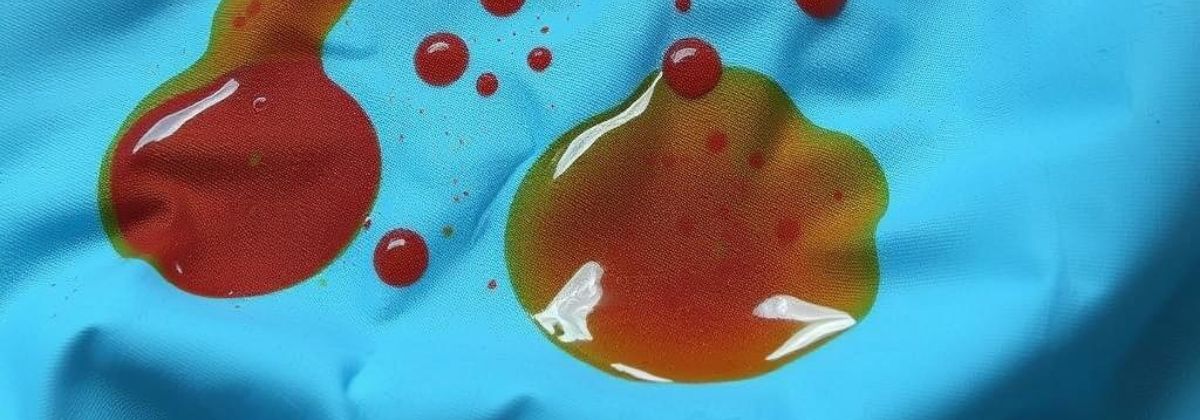12 Aug Cleaning Oil Stains from Clothes: A Step-by-Step Guide
Oil stains on clothes are among the most common and frustrating types. Whether from cooking, motor oil, or a greasy snack, oil can seep into the fabric and hold on tight. Addressing these stains quickly prevents them from becoming permanent marks on your favourite garments. In this guide, we’ll walk you through the best methods for cleaning oil stains from clothes to keep your wardrobe fresh and clean.
Cleaning Oil Stains from Clothes
Types of Oil Stains
Not all oil stains are created equal. The most common types include:
- Cooking Oil: Whether it’s olive oil, vegetable oil, or butter, cooking oils are frequent culprits of clothing stains.
- Motor Oil: Grease and oil can leave particularly tough stains, often accompanied by grime and dirt.
- Body Oils: Natural oils from the skin, such as sebum, can also stain clothing, especially in areas like collars and cuffs.
Pre-Treatment Techniques
Proper pre-treatment is crucial for effectively tackling oil stains. This step breaks down the oil before the garment is washed, increasing the chances of complete stain removal.
The Role of Washing-Up Liquid in Breaking Down Oil
Washing-up liquid, designed to cut through dish grease, works wonders on oil stains. Apply a small amount directly to the stained area, gently work it into the fabric with your fingers or a soft brush, and let it sit for 10-15 minutes. This allows the detergent to penetrate the fibres and break down the oil, making it easier to wash.
Using Liquid Laundry Detergent for Pre-Treatment
Liquid laundry detergent is another effective pre-treatment option. Similar to washing-up liquid, it can help dissolve the oil. Apply it directly to the stain, ensuring it covers the affected area. Allow it to sit for a few minutes before washing. This method is particularly useful for larger or more stubborn stains.
Applying a Stain Remover: When and How?
A commercial stain remover can be a game-changer for particularly tough stains. These products are formulated to tackle difficult stains like oil. Follow the instructions on the packaging, and always test the product on a hidden part of the fabric first to avoid any potential damage or discolouration. Apply the stain remover, let it sit as recommended, and then proceed with washing the garment.
Pre-treatment is a vital step in the battle against oil stains. By addressing the stain early and using the right products, you significantly improve your chances of restoring your clothing to its original, stain-free state.
Step-by-Step Guide to Cleaning Oil Stains from Clothes
Materials Needed
Before you start, gather the following materials:
- Paper towels or a clean cloth
- Liquid dish soap (preferably one designed to cut through grease)
- Baking soda
- An old toothbrush or soft brush
- Warm water
- Laundry detergent
- Washing machine
Step 1: Blot the Stain
- Why It’s Important: Blotting the stain immediately helps absorb as much excess oil as possible before penetrating deeper into the fabric.
- How to Do It: Use a paper towel, napkin, or clean cloth to gently blot the stained area. Avoid rubbing, which can spread the stain or push the oil further into the fibres.
Step 2: Apply Dish Soap
- Why It Works: Dish soap is formulated to cut through grease, effectively breaking down and lifting oil stains from fabric.
- How to Apply: Pour a small dish soap directly onto the stain. Gently work the soap into the fabric with your fingers or an old toothbrush, ensuring it covers the entire stained area. Let it sit for 5-10 minutes to allow the soap to penetrate and break down the oil.
Step 3: Use Baking Soda
- Why It’s Effective: Baking soda is a natural absorbent that helps draw out the remaining oil from the fabric.
- How to Use: Sprinkle a generous amount of baking soda over the dish soap-treated stain. Use the toothbrush to gently scrub the baking soda into the fabric. As you scrub, you might notice the baking soda clumping together—this means it’s absorbing the oil.
Step 4: Rinse and Check
- Why This Step Matters: Rinsing removes the soap and baking soda, allowing you to check the progress and determine if the stain has been fully removed.
- How to Rinse: Rinse the stained area with warm water, ensuring all the soap and baking soda is washed away. Carefully inspect the area to see if the stain is still visible. Repeat steps 2 and 3 if any oil remains until the stain is completely gone.
Step 5: Wash Normally
- Why You Should Wash Last: Washing removes any residual oil and cleaning agents from the fabric.
- How to Wash: Follow the care instructions on the garment’s label, using the warmest water temperature that is safe for the fabric. After washing, check the stain again before drying. If the stain is gone, you can dry the garment as usual. If any trace of the stain remains, avoid using the dryer, as heat can set the stain permanently. Instead, repeat the cleaning process or allow the item to air dry and try again.
Additional Tips
1. Dealing with Old or Stubborn Stains
- Repeat the Process: If the oil stain has set or is particularly stubborn, you may need to repeat the cleaning process several times. Each dish soap and baking soda round can help lift more of the stain.
- Pre-Treatment Products: For oil or grease stains, use a commercial stain remover. Apply the product according to the instructions and let it sit for the recommended time before washing.
2. Alternative Methods
- Chalk or Talcum Powder: For fresh oil stains, rubbing white chalk, talcum powder, or cornstarch into the stains can help absorb the oil. Let the powder sit on the stain for 10-15 minutes before brushing it off and following up with dish soap.
- Baby Powder: Like talcum powder, baby powder can absorb oil. Apply it generously to the stain, let it sit, and then brush it off before washing.
3. Hot Water vs. Cold Water
- Choosing the Right Temperature: While warm water is generally recommended for removing oil stains, certain fabrics may require cold water to avoid damage. Always check the garment’s care label before washing. Cold water can be used with dish soap and baking soda for delicate fabrics, though the process may take longer.
4. Drying After Stain Removal
- Air Drying: If unsure whether the stain has been fully removed, it’s best to air dry the garment. Heat from a dryer can set the stain permanently if it hasn’t been completely removed.
- Sun Drying: Hanging the garment in direct sunlight can help naturally fade any remaining traces of the stain. Be cautious with brightly coloured fabrics, as prolonged sun exposure can cause fading.
5. NeatEx Professional Dry Cleaning
- If the garment is made of delicate fabric or the stain persists despite your best efforts, consider taking it to us. We have specialized solvents and techniques that effectively remove tough oil stains without damaging the fabric.
6. Preventative Measures
- Wear an Apron: When cooking or handling greasy substances, wearing an apron can help protect your clothes from oil stains.
- Quick Action: The sooner you address an oil stain, the easier it is to remove. Keep a stain removal kit with dish soap, baking soda, and a small brush for on-the-go treatment.
By considering these additional tips, you’ll be better equipped to handle even the toughest oil stains and keep your clothes looking their best.
The Lasy Word
Oil stains can be challenging to remove, but you can successfully clean them from your clothes with the right approach. Remember to act quickly, blot the stain, and use the right products, like dish soap and baking soda. By following these steps for cleaning oil stains from clothes, you’ll be able to keep your clothes looking their best, no matter what spills your way.




Sorry, the comment form is closed at this time.